Tarte Tatin must be one of my favourite desserts of all time: caramelised melt-in-your-mouth apples with a flakey buttery puff pastry. Great recipe!
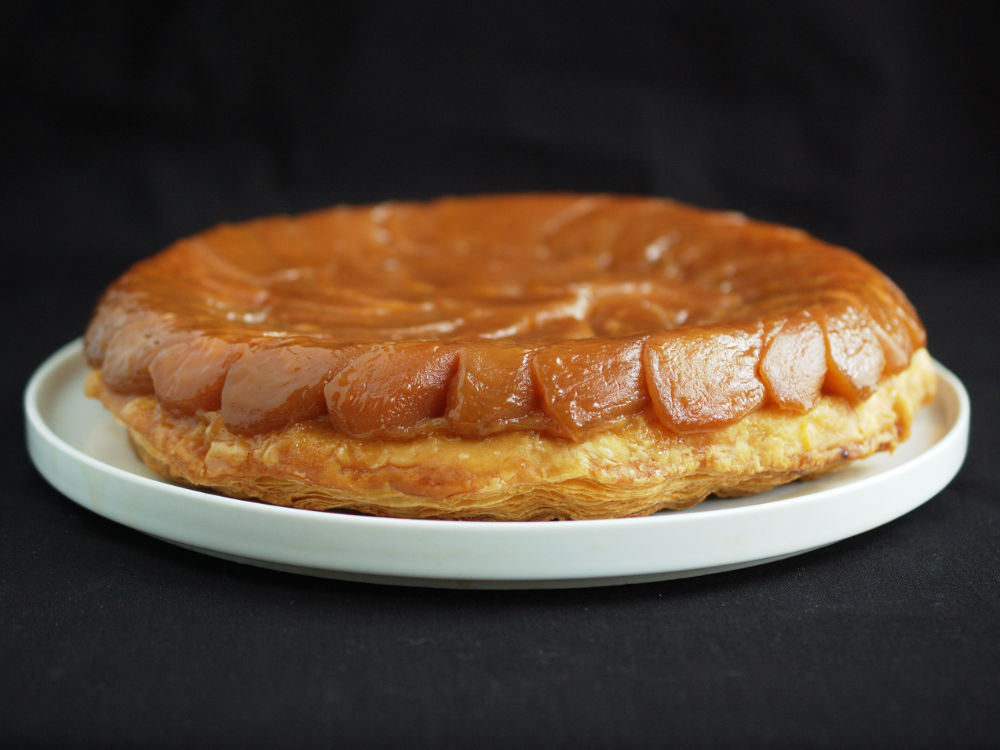
The history of apple tarte tatin
A caramelized apple pie baked upside down, with the dough on top of the filling. Tatin tart has become one of the most famous French desserts in the world. Easy and economical, it can be prepared with just five ingredients: apples, sugar, butter, flour, and salt.
But do you know its origin?
The tarte tatin dates back to the 19th century. Legend has it that the tart was created near Paris in the kitchens of the Hotel Tatin, run by sisters Caroline and Stéphanie Tatin. One of their specialties was apple pie.
On one particularly busy day, rushing to finish preparing all the apple tarts, they forgot to line one pan with the dough and instead added the apples, the butter, and sugar and placed the pane in the oven. By the time they noticed their mistake, it was already too late. One of the sisters had the idea to add the dough on top of the apples. Maybe they could salvage the tart this way.
The tarte tatin was born!
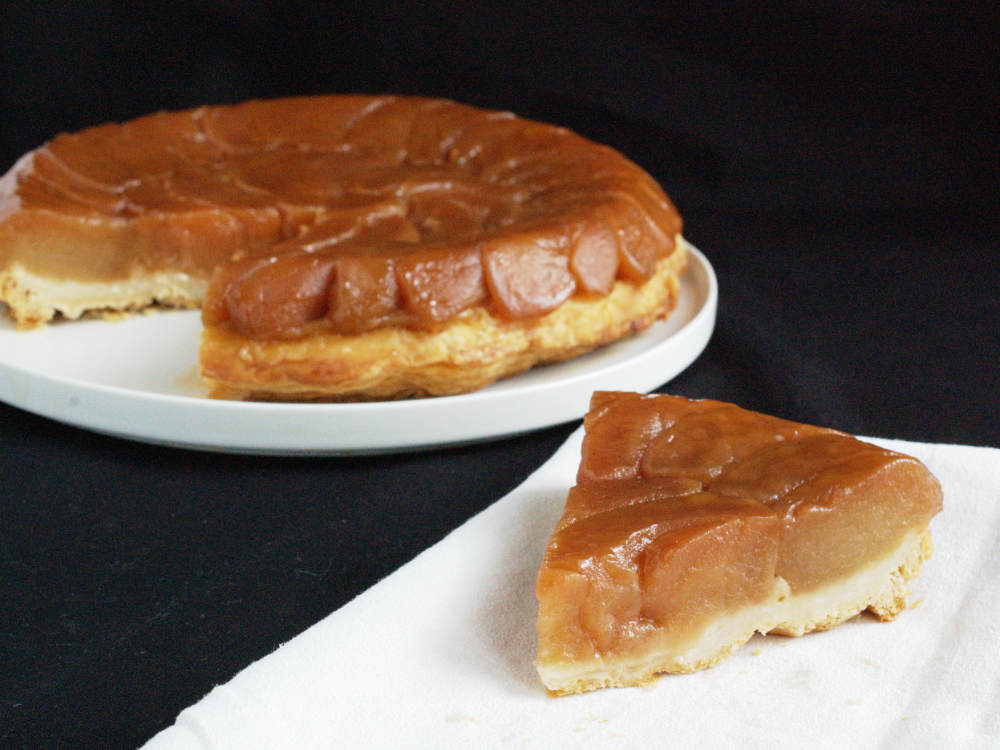
Christophe Michalak’s recipe
Traditionally, apples are caramelized in sugar and butter before being baked with the pastry base on top. Although this technique works well, I find that you often end up with messy looking pies. The apples release a lot of water during baking, which causes them to both shrink and move once you turn out the tart.
I was therefore immediately intrigued by French pastry chef Christophe Michalak’s poaching technique.Rather than frying apples in a caramel pan before baking, Christophe Michalak pouches apples in butter/water/sugar syrup before baking them in the oven.
The process of poaching the apples makes them more soft and malleable. This allows you to pack them tightly in the pan and to add twice as many apples as in a traditional tarte tatin!
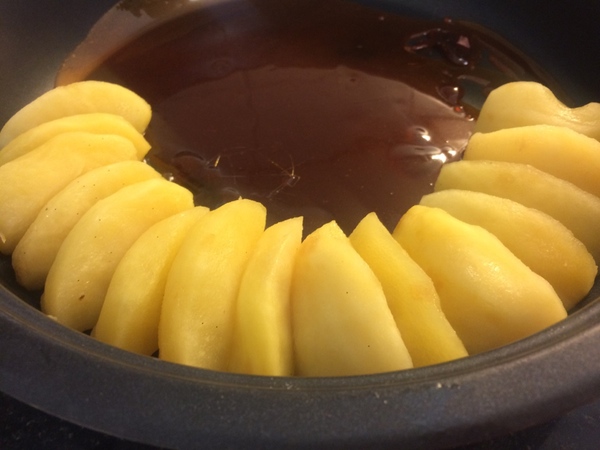
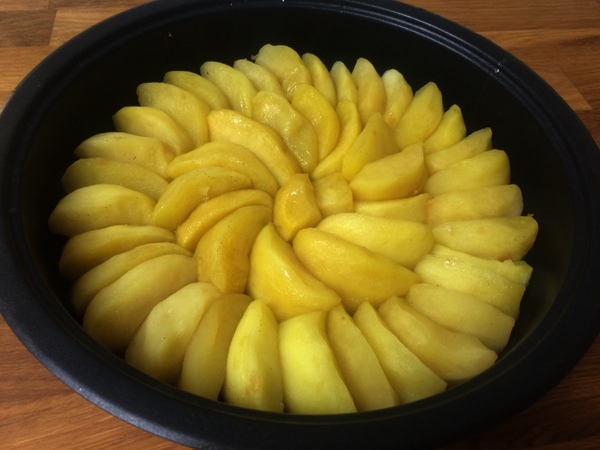
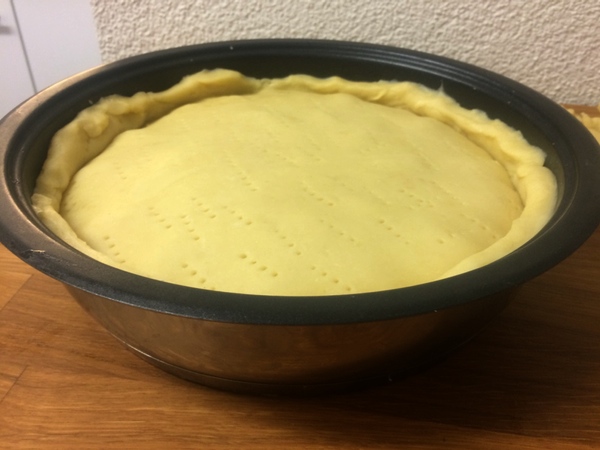
Don’t be afraid of the amount of sugar and butter!
I’ve made a couple of changes to the original recipe. In his version, Christophe Michalak calls for 1kg of sugar, 1 kg of butter and 1 liter of water for the poaching syrup. I’ve cut those quantities to 250 g of sugar, 250 g of butter and 350 ml water. This is still a lot, but don’t be put off by the amount of butter and sugar required – most of it is in the poaching syrup. Although the apples will suck up some of the fat during poaching, most of it doesn’t make it into the final dish. The end result is very balanced and not too sweet.
The second change I made was the oven settings. Michalak recommends using the fan oven setting and cooking the tart at 180°C for 30-40min. When I use the fan with my oven, my bakes tend to be uneven and burn, so I used my regular settings instead. I placed the rack in the bottom part of the oven and baked the pie until the apples had caramelized (in my oven this took about 2h, but this will depend on each oven).
The crust will retract a bit over time, so you will be able to see the color of the apples. If like me you choose to use your regular settings, make sure to cover the tart with foil once the crust is a golden color so it doesn’t burn.
Which apples to use for the tatin pie
This recipe is all about the apples, so make sure to pick the right ones! You want apples which will hold their shape while cooking and not get smushed up. You can use any of the below:
- Boskoop
- Braeburn
- Canada
- Golden
- Queen of reinettes
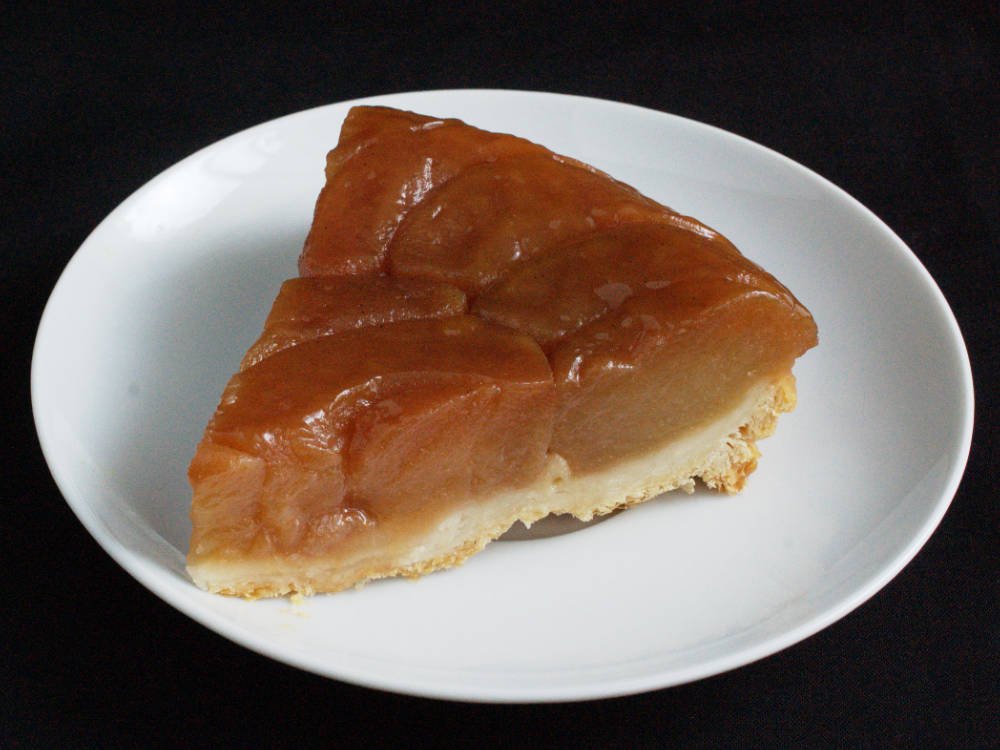
Tarte Tatin by Christophe Michalak
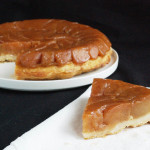
Tarte Tatin is one of my favourite desserts all time: caramelised melt-in-your-mouth apples with a buttery puff pastry.
For the caramel:
- 100 g (1/2 cup) sugar
Poaching the apples:
- 10 Royal Gala apples
- 250 g (1 + 1/4 cup) sugar
- 250 g (2 sticks) butter
- 350 g (1 + 1/2 cup) water
- 1 vanilla pod
Assembling the tart:
- 250 g 1 packet puff pastry
- apple/apricot/quinces jam (for the shine)
Prepare the caramel:
- Start by adding 1/3 of the sugar to the pan and cooking at a medium heat until the sugar has completely dissolved, then add some more sugar and repeat the steps until all the sugar has melted. Note: do not stir the sugar as it will cause it to cristallise. If you need to mix the sugar and caramel to prevent it from burning, take the pan off the heat and swirl the pan so that the raw sugar and caramel mix together.
- Once the caramel reaches a nice amber colour, pour it into a 20/22cm (8-9 inches) tart tatin or pie tin and spread as evenly as possible. The caramel will solidify.
Poaching the apples:
- Peel and core the apples and cut them into 4.
- Bring the butter, sugar, water and vanilla pod to the boil in a small but high pan. Once the butter has melted, mix well and poach the first batch of apples. Stir and turn the apples 2-3 times. The apples should be translucent and should not be resistant when you stick a knife into them. Be careful not to overcook them or they will turn into mush. When your first batch is complete, set aside and poach the next apples. Repeat until all apples are poached.
Assemble & bake the tart:
- Start placing the apple on the outside edge with the apple slice facing down and work your way in (see picture below). The apples should be as tightly packed as possible – the tighter you squeeze the apples, the more you can fit in! The poaching makes the apples quite soft and malleable, so it should be pretty easy to fit them tightly together. Press down on the apples to make sure they’re all compact and at the same height.Ideally, it would be better to leave the apples once placed in the tin to infuse over night. Not only will they be more packed in flavour but they will also set better. If you wish to do so, just cover the apples in cling film and leave in the fridge overnight.
-
Roll out the puff pastry to a 3-4 mm thickness. Peel the dough off from the table before cutting the shape out as it will contract and get smaller. Place the dough back on the table and cut out a circle the size of the Tarte Tatin tin + 2cm. Use a fork to poke holes in the dough to prevent it from puffing up whilst baking. Place the dough in the fridge for a few hours (or overnight) – this will also prevent the dough from shrinking during the baking.
- Place the dough on the poached apples, and press down so that the dough is directly in contact with the apples. Press the edges of the dough against the side of the the tin so as to seal the pie.(this is hard to describe, so look at the picture below).
- The original recipe recommends baking the pie for 30-40 min at 180°C using the fan, but I used my regular settings and baked the pie for about 2h at 180°C with the rack placed in the bottom part of the oven. To prevent the pastry from over cooking, place some foil over it once golden and continue to bake until the apples are a nice caramelised colour.
-
Let the tart cool a for 30 min before flipping it. To do this, place a plate on the crust and flip the tin. The Tarte Tatin should come out nicely.
- Melt a bit of jam in a small pan. Brush the apples with a bit of jam to give it an extra shine.
Note: this Tart Tatin can be prepare a day or even a week in advance and stored either in the fridge (the day before) or the freezer (a week in advance). Just prepare the apples and place the dough on the tart before storing.
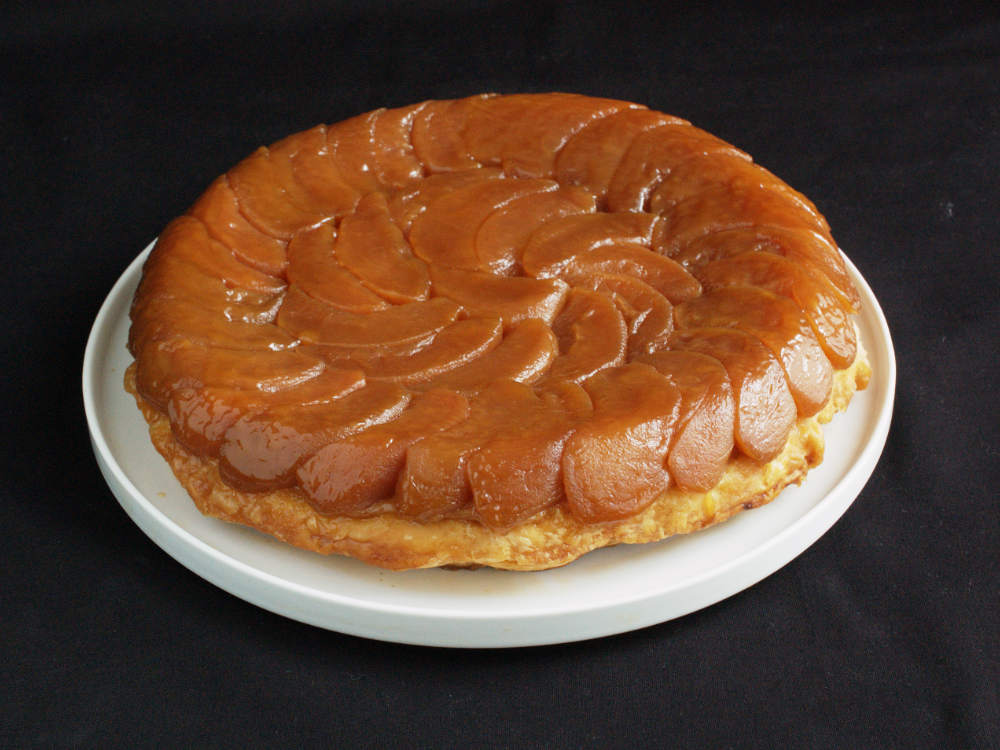
This was the first of your delicious deserts I tried and it still is one of y favourits. Continue baking and inspiring Nathalie!
Thank you for sharing this recipe. Unfortunately I do not have a tarte tatin pan, but can I use a shallow 8″ or 9″ cake pan? Or a 6″ cake ring for a smaller tarte tatin?
Hi Miya! My tart tatin pan is about 10″ across and just under 2.5″ deep. Your larger shallow cake pan should work if it is deep enough, as would a deep oven-safe frying pan between 8″ and 10″ (in general, smaller pans require fewer poached apples). Cake rings wouldn’t work for this because the melted caramel and apple juice released during baking need to stay in the pan. Good luck!!
What can i say ?… i tried it and it was a blast, to be honest when i was making it i had some doubts about it. The result was fantastic far better than what we found in many patisseries here in Paris, beautifful and tasty
Hi Nathalie – Since a return trip to Normandy last fall – one of our favorite parts of France – I’ve made your recipe several times, with both great reactions and several observations:
1. Gala apples have served very well. Depending on how juicy they are, the baking process can generate a lot of juice that can be poured off before flipping — else you can have a kitchen floor covered with a sugary mess.
2. A generous splash of Calvados in the poaching liquid helps — can’t hurt — also serves as a reminder of Normandy.
3. I’ve had good results instead of using puff pastry to use one of my standard pie crusts — a choice that everyone can consider.
4. Your suggested amount of sugar to be caramelized did not suffice to cover my pie tins — so I raised it by 50%. It takes a steady hand and keen watching to melt that amount of sugar without burning it — but the results are worth it.
Hi Jim,
Thanks for your feedback – I’ll definitely have to try the Calvados in the poaching syrup!